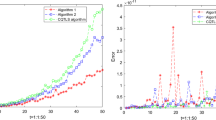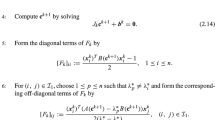Abstract
Polar harmonic transforms (PHTs) are superior to Zernike moments and Pseudo-Zernike moments in terms of higher speed and numerical stability. Despite all these advantages, there is still a need for fast computing algorithms for real-world applications. So far, the approaches used in boosting the computational speed of PHTs include recursive relation and symmetric/anti-symmetric properties of kernel functions. Taking advantage of these two approaches, a new class of computational framework has been presented to compute the kernel functions with a minimal number of arithmetic operations. The proposed computational framework reduces the number of additions/subtractions from 56 to 24 and the number of multiplications from 12 to 8 compared to existing fast methods. The experimental results show that the proposed method is around 1.4 times faster than that of the existing fastest algorithm.





Similar content being viewed by others
References
Yap, P., Kot, A., & Jiang, X. (2010). Two-dimensional polar harmonic transforms for invariant image representation. IEEE Transactions on Pattern Analysis and Machine Intelligence, 32(7), 1259–1270.
Singh, S. P., Urooj, S., & Lay-Ekuakille, A. (2016). Breast cancer detection using PCPCET and ADEWNN: a geometric invariant approach to medical X-ray image sensors. IEEE Sensors Journal, 16(12), 4847–4855.
Singh, S. P., & Urooj, S. (2015). Combined rotation-and scale-invariant texture analysis using radon-based polar complex exponential transform. Arabian Journal for Science and Engineering, 40(8), 2309–2322.
Singh, S. P., & Urooj, S. (2016). Three types of moment invariants for color object recognition based on radon and polar harmonic transform in Cℓ (0, 2) space. Arabian Journal for Science and Engineering, 41(8), 3051–3060.
Li, Y. Y. N. (2013). Quaternion polar harmonic transforms for color images. IEEE Signal Processing Letters, 20(8), 803–806.
Li, Y. Y. N., Wang, P., & Su, Y. T. Y. (2015). Robust image hashing based on selective quaternion invariance. IEEE Signal Processing Letters, 22(12), 2396–2400.
Li, Y. (2013). Image copy-move forgery detection based on polar cosine transform and approximate nearest neighbor searching. Forensic Science International, 224(1–3), 59–67.
Li, L., Li, S., Abraham, A., & Pan, J. S. (2012). Geometrically invariant image watermarking using polar harmonic transforms. Information Sciences, 199, 1–19.
Li, L., Li, S., Zhu, H., & Wu, X. (2014). Detecting copy-move forgery under affine transforms for image forensics. Computers and Electrical Engineering, 40(6), 1951–1962.
Li, L., Li, S., & Wang, J. (2012). Copy-move forgery detection based on PHT. In IEEE World Congress on Information and Communication Technologies (WICT) (pp. 1061–1065).
Tsougenis, E. D., Papakostas, G. A., Koulouriotis, D. E., & Tourassis, V. D. (2013). Towards adaptivity of image watermarking in polar harmonic transforms domain. Optics and Laser Technology, 54, 84–97.
Qi, M., Li, B.-Z., & Sun, H. (2015). Image watermarking using polar harmonic transform with parameters in SL(2,R). Signal Processing: Image Communication, 31, 161–173.
Singh, S. P., & Urooj, S. (2017). Accurate and fast computation of exponent Fourier moment. Arabian Journal for Science and Engineering, 42(8), 3299–3306.
Hoang, T. T. V., & Tabbone, S. (2014). Fast generic polar harmonic transforms. IEEE Transactions on Image Processing, 23(7), 2961–2971.
Yang, Z., & Kamata, S. I. (2010). Fast polar harmonic transforms. In: 11th International Conference on Control, Automation, Robotics and Vision, ICARCV 2010 (pp. 673–677).
Singh, C., & Kaur, A. (2015). Fast computation of polar harmonic transforms. Journal of Real-Time Image Processing, 10(1), 59–66.
Loeffler, C., Ligtenberg, A., & Moschytz, G. S. (1989). Practical fast 1-D DCT algorithms with 11 multiplications. International Conference on Acoustics, Speech, and Signal Processing, 2–5.
Khotanzad, A., & Hong, Y. H. (1990). Invariant image recognition by {Zernike} moments. IEEE Transactions on Pattern Analysis and Machine Intelligence, 12(5), 489–497.
Hu, H., & Kong, L. (2012). Image recognition based on radial harmonic Fourier moments and SVM. In Proceedings - 6th International Conference on Internet Computing for Science and Engineering, ICICSE 2012 (pp. 138–142).
Xiao, B., Ma, J. F., & Wang, X. (2010). Image analysis by Bessel-Fourier moments. Pattern Recognition, 43(8), 2620–2629.
Gonzalez, R. C., & Woods, R. E. (2007). Digital image processing (3rd Edition).
Author information
Authors and Affiliations
Corresponding author
Additional information
Publisher’s Note
Springer Nature remains neutral with regard to jurisdictional claims in published maps and institutional affiliations.
Rights and permissions
About this article
Cite this article
Singh, S.P., Urooj, S. A New Computational Framework for Fast Computation of a Class of Polar Harmonic Transforms. J Sign Process Syst 91, 915–922 (2019). https://doi.org/10.1007/s11265-018-1417-0
Received:
Revised:
Accepted:
Published:
Issue Date:
DOI: https://doi.org/10.1007/s11265-018-1417-0




